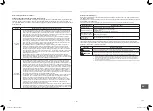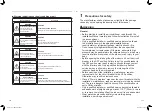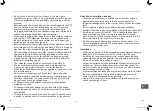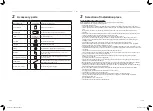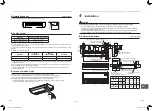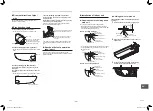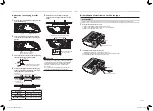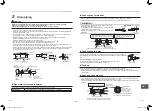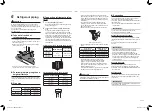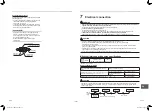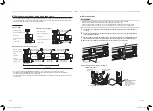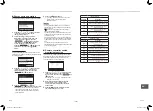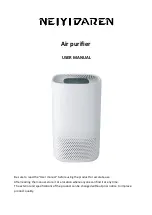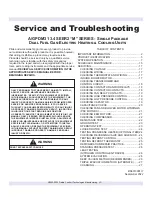
• After the work has finished, use an insulation tester set
(500V Megger) to check the resistance is 1M
Ω
or more between
the charge section and the non-charge metal section (Earth/Ground
section).
If the resistance value is low, a disaster such as a leak or electric
shock is caused at user’s side.
• Upon completion of the installation work, check for refrigerant
leaks and check the insulation resistance and water drainage.
Then conduct a test run to check that the air conditioner is
operating properly.
Explanations given to user
• Upon completion of the installation work, tell the user where the
circuit breaker is located. If the user does not know where the
circuit breaker is, he or she will not be able to turn it off in the
event that trouble has occurred in the air conditioner.
• If the fan grille is damaged, do not approach the outdoor unit but
set the circuit breaker to the OFF position, and contact a qualified
service person to have the repairs done. Do not set the
circuit breaker to the ON position until the repairs are completed.
• After the installation work, follow the Owner’s Manual to explain
to the customer how to use and maintain the unit.
Relocation
• Only a qualified installer or qualified service person is
allowed
to relocate the air conditioner. It is dangerous for the air
conditioner to be relocated by an unqualified individual since a
fire, electric shocks, injury, water leakage, noise and/or vibration
may result.
• When carrying out the pump-down work shut down the
compressor before disconnecting the refrigerant pipe.
Disconnecting the refrigerant pipe with the service valve left open
and the compressor still operating will cause air or other gas to
be sucked in, raising the pressure inside the refrigeration cycle to
an abnormally high level, and possibly resulting in rupture, injury
or other trouble.
CAUTION
New refrigerant air conditioner installation
• This air conditioner adopts the new HFC refrigerant (R410A)
which does not destroy ozone layer.
• The characteristics of R410A refrigerant are easy to absorb
water, oxidizing membrane or oil, and its pressure is approx.
1.6 times higher than that of refrigerant R22. Accompanied with
the new refrigerant, refrigerating oil has also been changed.
Therefore, do not let water, dust, former refrigerant, or
refrigerating oil enter the refrigerating cycle during installation
work.
• To prevent charging an incorrect refrigerant and refrigerating oil,
the sizes of connecting sections of charging port of the main unit
and installation tools are changed from those for the conventional
refrigerant.
• Accordingly the exclusive tools are required for the new
refrigerant (R410A).
• For connecting pipes, use new and clean piping designed for
R410A, and please care so that water or dust does not enter.
� 6 �
11-EN
12-EN
EN
1115652713-1_EN,FR,ES.indd 7
25/3/2565 15:46:06



